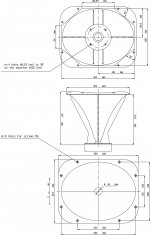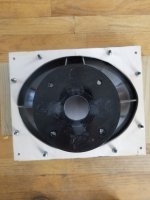IMHO, JBL's "Image Control Waveguide" is simply a new twist on an old concept: a diffraction horn.
...
Hello,
This is all old stuff with the edges rounded and polished.
I think of the Image Control Waveguide throats as image control weirs with well-rounded geometry. The sound travels the paths of least impedance.
Someone needs to get close and measure the distortion differences among horn throats with sharp diffraction slots, these “new” ICW’s with well-rounded geometry and throats with no groves or notches.
It may well be that in our small audiophile listening rooms that we may not perceive a difference.
Thank You DT
I tend to think of a "diffraction" "horn" as:
1 (diffraction): where there is a "pinch" ("negative" angle relative to the output angle of the driver). Of course all waveguides (and as a subset:horns) in conventional applications have diffraction, but a "pinch" design necessarily generates additional diffraction within the operating pass-band (without control phasing/pathing - like that found in the actual compression driver).
2 (horn): where the waveguide's emphasis is on gain rather than controlling dispersion.
1 (diffraction): where there is a "pinch" ("negative" angle relative to the output angle of the driver). Of course all waveguides (and as a subset:horns) in conventional applications have diffraction, but a "pinch" design necessarily generates additional diffraction within the operating pass-band (without control phasing/pathing - like that found in the actual compression driver).
2 (horn): where the waveguide's emphasis is on gain rather than controlling dispersion.
Scott, isn't there a third:
3(waveguide): where the device does not have any diffraction "pinch" and the emphasis is on controlling directivity (In physics "dispersion" means something different,) not gain. I don't care about gain - amps do that.
3(waveguide): where the device does not have any diffraction "pinch" and the emphasis is on controlling directivity (In physics "dispersion" means something different,) not gain. I don't care about gain - amps do that.
Sure, and a 4th: (..at least under my lay definition.)
-a "diffraction waveguide" that focuses on dispersion (regardless of gain) and utilizes that diffraction "pinch" for a wider dispersion near-axis in the top octave (..to a limit of course).
Not really something you'll see for a 1" exit driver.. but with larger CD exit diameters manufacturers start looking for ways to "cheat".
-a "diffraction waveguide" that focuses on dispersion (regardless of gain) and utilizes that diffraction "pinch" for a wider dispersion near-axis in the top octave (..to a limit of course).
Not really something you'll see for a 1" exit driver.. but with larger CD exit diameters manufacturers start looking for ways to "cheat".
In any event, I don't think the JBL "Image Control Waveguides" are either diffraction elements or horns. The profile expands out from the "entry" (even if variable with its profile) and the design is focused on dispersion irrespective of gain.
As an alternative, note the "pinch" in the XT1464 at the "entry":
As an alternative, note the "pinch" in the XT1464 at the "entry":
Attachments
Last edited:
The XT1464 is definitely not pinched. But the smaller XT1086 has something that is leaning towards a pinch (it is not getting narrower actually towards the mouth but it does start a little later to expand in the horizontal direction than it does in the vertical). And the XR1496 is definitely pinched but in a rather smooth way IMO. This is a 1.4" 90 degrees horn that I would definitley like to hear.
Last edited:
My limited experience with horns is the pinch in the throat diffraction slot is to extend the lower bandwith to the detriment of the higher frequencies not propagating
Trying to get too much when I think it is wiser to use a high frequency horn for 1200hz above then a mid waveguide horn 300 -1200 and whatever pleases you below
The jbl m2 waveguide keeps getting brought up but my understanding is that their is a lot of dsp applied, someone think (POS) member posted the requirements
Trying to get too much when I think it is wiser to use a high frequency horn for 1200hz above then a mid waveguide horn 300 -1200 and whatever pleases you below
The jbl m2 waveguide keeps getting brought up but my understanding is that their is a lot of dsp applied, someone think (POS) member posted the requirements
Last edited:
The XT1464 is definitely not pinched.
..but 18 Sound's diagram *clearly shows that it is, and the polar map's "agree" with a top-octave pattern that would not be there without it. 😕
*Maybe a better look is required through the PDF with "zoom-in" capability:
http://www.eighteensound.com/Portals/0/PDFs/XT1464.PDF
..in addition to the "pinch" near entry (shown on 2nd/side-profile diagram), the centered "double ring" from the diagram for the CD connection plate (shown on 1st/rear-profile diagram) - also presents this: the entry is a larger diameter "ring" than the interior "ring" that shows the "pinch" character. (..at least this is the sort of behavior I get with 2d view when working with 3d CAD.)
Last edited:
I am actually listening to mine at the very Moment. Let me see whether a mobile phone picture is worth anything.
I am actually listening to mine at the very Moment. Let me see whether a mobile phone picture is worth anything.
It would have to be from the rear (with good lighting and CD detached). Looking down the throat will really (likely) only show the most constrained portion, as seen from the 3rd/mouth diagram. 😉
Now if the "pinch" was further toward the mouth (rather than being such a small/short transition).. THEN you might be able to pick up the difference from the front.
Last edited:
I will post them tomorrow because it is easier to do it with the pc than with the phone. Visibliy there is no pinching. Probing with the index finger makes the impression of a veeeery slight pinching.
The jbl m2 waveguide keeps getting brought up but my understanding is that their is a lot of dsp applied, someone think (POS) member posted the requirements
DSP won't do anything for waveguide's dispersion character.. you can smooth out (linearize) the overall profile, but it never alters the dispersion.
It's not pinched at all...I have one laying loose.
Picture? (rear.)
I only ask because it's not what is shown in the datasheet diagram. 😱 (..at least as I'm reading it.)
I will post them tomorrow because it is easier to do it with the pc than with the phone. Visibliy there is no pinching. Probing with the index finger makes the impression of a veeeery slight pinching.
Yeah, I 'felt' that slight pinching too, but couldn't see any, so I got a caliper out that measures bores.
What we feel appears to be the transition from mounting flange to horn curvature, but it doesn't really constrict at all.
I have here an XT1464Y ( an OEM version made for Yorkville ) and it's definitely not pinched from entry through to flare.
🙂
PS; I see in the second pic of the pdf it shows a 1.4" entry that necks-down to about 1" before starting it's expansion >> mine is certainly not like that!
🙂
PS; I see in the second pic of the pdf it shows a 1.4" entry that necks-down to about 1" before starting it's expansion >> mine is certainly not like that!
Last edited:
Picture? (rear.)
I only ask because it's not what is shown in the datasheet diagram. 😱 (..at least as I'm reading it.)
No problem...seeing is believing, huh? 🙂
Attachments
I think I know why people think it might be pinched: That stiffening thingie ( some sort of ridge, don't know how it is called in English) on the outside is shaped such that it could be mistaken for the outside of a pinched horn contour. You can see it quite well on the Thomann website.
No problem...seeing is believing, huh? 🙂
😀
Actually it does look like there is one from the photo.. 😱
Yeah, I'm guessing it's a manufacturing plastic weld. (..joining connection plate to horn, assuming it's totally flat to that interior diameter.)
Their data sheet need's to be revised (IMO). Being familiar with CAD, what they are showing in their sheet is NOT what they are selling. (..and while the end-result isn't a bad thing, it does cause confusion.)
Last edited:
- Home
- Loudspeakers
- Multi-Way
- 1.4" or 2" throat large constant directivity horns you can actually buy!


